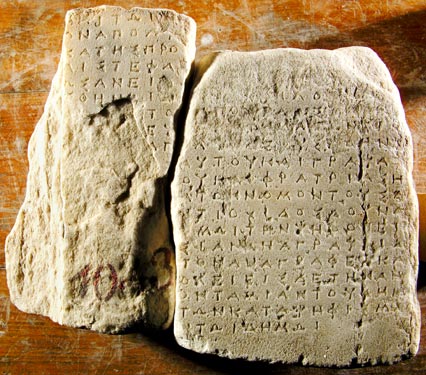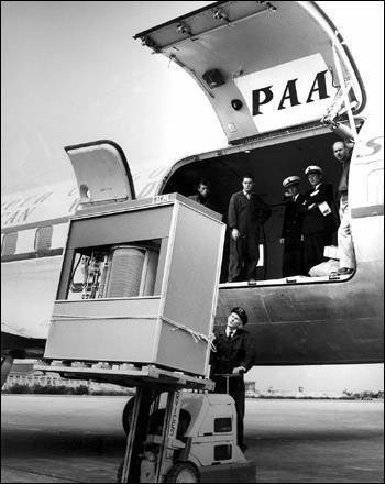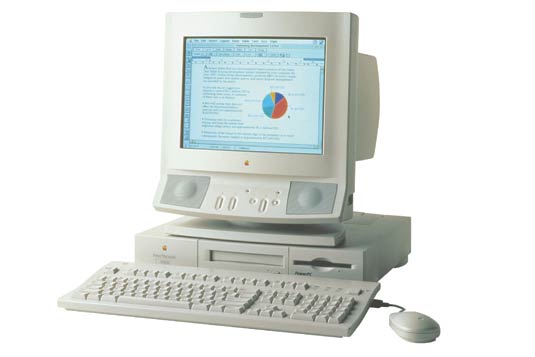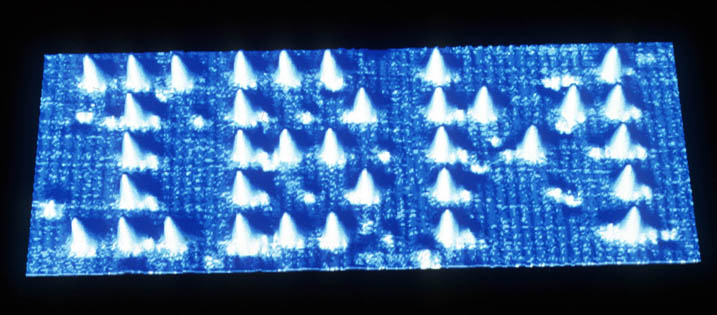
People have been storing information since the stone ages, ever since they’ve been writing or putting art on tablets and walls. With the invention of paper and ink, the “density of information” increased significantly, packing a lot more information into a tighter space (such scrolls and eventually bound books, as we still use today).
The invention of printing didn’t substantially increase the density of information, though it greatly contributed to its dissemination by making information easier to copy. In the 20th century, the benchmark for a sizable chunk of information became the Encyclopedia Britannica.
The 2010 edition (the last print-edition that Encyclopedia Britannica will ever publish) consists of 32 volumes and weighs 129 pounds. (Source) At 50 million words or about 300 million characters, it requires roughly gigabyte to store the text electronically (leaving out images and diagrams).

In an age of thumb drives that weigh less than an ounce and that, these days, routinely hold 8 or 16 gigabytes, paper and ink doesn’t seem like a very efficient way to store information. But electronic storage wasn’t always so efficient.
Have a look at the following picture, taken in 1956. What is being taken out of that old Pan Am airliner?

What you see here is the hard drive for IBM’s 305 RAMAC computer. That hard drive, weighing over 2,000 pounds, stored a whopping 5 megabytes (not gigabytes!). It would take 200 of these to store the Encyclopedia Britannica.
The 350 Disk File consisted of a stack of fifty 24-inch discs… The capacity of the entire disk file was 5 million 7-bit characters, which works out to about 4.4 megabytes in modern parlance. This is about the same capacity as the first personal computer hard drives that appeared in the early 1980s, but was an enormous capacity for 1956. IBM leased the 350 Disk File for a $35,000 annual fee. (Source)
Note that this hard drive cost $35,000 in 1956 dollars not to buy but to rent. According to the consumer price index, $35,000 back then was worth more than $295,000 in 2012 buying power.
Of course, Moore’s law, which says that computational power doubles every 18 months, guaranteed that both cost and information density would come tumbling down. By 1980, a five megabyte Seagate hard drive could sit comfortably on your desktop and cost you only $5,000 (that is, $12,600 in 2012 buying power). A 1 gigabyte hard drive in 1980 weighed 500 pounds. (Source)
By 1987, your standard Macintosh computer was coming with 20 megabytes of storage. By 1990, you could, for a few hundred dollars, swap out those 20 megabytes for a then “large” 100 megabyte hard drive. And by 1996, Macs were coming with a one or two gigabytes of storage.

So, by 1996, the standard hard drives of desktop computers could finally hold the full Encyclopedia Britannica.
Information on hard drives is stored on a two-dimensional surface, so it makes sense to ask how many bits or bytes are stored per square inch, centimeter, or any other unit of length.
The information density of IBM’s 305 RAMAC came to 250 bytes per square inch. Compact disks (or CDs), which have been popular since the 1980s and are also a two-dimensional storage medium, have an information density of about 1 gigabyte per square inch.
This level of density for CDs may see a bit generous given that a standard CD is over 4 inches in diameter and contains less than a gigabyte of information. But the tracks on a CD are about three times as far apart as the width of a track (the pits that make up a track are about half a micrometer in width), so this measure of CD information density omits a lot of the unused space on the CD.
DVDs, by using smaller pits and tighter packing of tracks, have an information density of slightly more than 2 gigabytes per square inch. And Blu-ray can take information density up to 12 gigabytes per square inch.
Commercial hard drives have increased their information density well beyond this, and are now in the several 100s of gigabytes per square inch.
Flash memory, because it’s solid state and allows the possibility of 3-D stacking, has an information density measured in nanometers. Logic gates that store information for flash memory are now around 20 nanometers (recall that the pits that store the memory in a CD are .5 micrometers in width, or 500 nanometers).
While all this increase in density of information storage for commercially available devices is impressive, we can do much better. For instance, cellular life has developed highly dense information storage. The DNA inside any human consists of roughly 1 gigabyte of information (3 billion nucleotide base pairs, so this is the right order of magnitude).
The DNA double-helix is 2 nanometers in diameter and rises 3.4 nanometers at each winding, also adding roughly 10 nucleotides at each winding. Do the math, and one finds that DNA stores information at a density of about 10^18, or a billion billion, bytes per cubic millimeter (i.e., 1 exabyte per mm^3). Because 1 inch is 25.4 millimeters, that’s a density of roughly 10^22, or ten billion trillion, bytes per cubic millimeter (i.e., 10 zettabytes per mm^3).
Commercial electronic devices therefore don’t even come close to the information storage in the DNA of biological systems. A 1 gigabyte memory component of thumb drive made out of not flash but DNA memory would only need a diameter of 10 micrometers (human hair is between 17 and 180 micrometers in diameter; 1000 micrometers make a millimeter). The DNA from every species that has ever existed over the billions of years of evolution could be fit into a teaspoon.
As impressive as the information density of DNA is, physics allows for information storage at a much greater density still. DNA is a complex molecule and even the nucleotide bases that store genetic information are reasonably complex molecules, composed of numerous atoms. DNA therefore requires numerous atoms for each byte of information it stores.
But it is also possible to store information at the atomic level. Using dipolar coupled spins for quantum memory storage, researchers have been able to store 1,024 bits of data on a single 5CB (C18 H 19 N) molecule, which is roughly 27 bits per atom or slightly over 3 bytes per atom. That’s a significantly higher density of information storage than found in DNA. (Source)
But scientists have done even better than this. In 1959, physicist Richard Feynman offered a $1,000 prize for anyone who could shrink a page to 1/25,000 its size. Since a page is two dimensional, such a shrinkage would constitute an information density reduction by a factor of over 600 million, and could write the Encyclopedia Britannica on the head of a pin.

Not until 1985 did Feynman finally have to pay out his prize money. It went to researchers at Stanford who used “electron beam lithography to engrave the opening page of Dickens’A Tale of Two Citiesin such small print that it could be read only with an electron microscope.” (Source)
This record held until 1990, when researchers at IBM arranged 35 xenon atoms to form the IBM logo.

Finally, in 2009, researchers, back at Stanford, where able to improve on IBM’s miniaturization, making it 40 times smaller. Using electronic quantum holography, they were able to store
35 bits per electron to encode each letter [and] write the letters so small that the bits that comprise them are subatomic in size. So one bit per atom is no longer the limit for information density. There’s a grand new horizon below that, in the subatomic regime. Indeed, there’s even more room at the bottom than we ever imagined. (Source)
To sum up, in 1956, a 5-megabyte IBM hard drive weighed over a ton, or roughly 1,000 kilograms. In other words, that hard drive stored information at a density of 5 bytes per gram.
In 2009, Stanford researchers were able to store information at a density of 35 bits per electron, or roughly 4 bytes per electron. Since an electron weighs roughly 1 in 10^27 grams (i.e., one part in a thousand trillion trillion grams), that means the ultimate information density discovered to date weighs in (literally) at four thousand trillion trillion bytes, or 4 brontobytes (see appendix), per gram.
That makes our commercially available terabyte and petabyte storage devices seem crude.
APPENDIX: Disk Storage Reference
· 1 Bit = Binary Digit
· 8 Bits = 1 Byte
· 1000 Bytes = 1 Kilobyte= 10^3 Bytes
· 1000 Kilobytes = 1 Megabyte= 10^6 Bytes
· 1000 Megabytes = 1 Gigabyte= 10^9 Bytes
· 1000 Gigabytes = 1 Terabyte= 10^12 Bytes
· 1000 Terabytes = 1 Petabyte= 10^15 Bytes
· 1000 Petabytes = 1 Exabyte= 10^18 Bytes
· 1000 Exabytes = 1 Zettabyte= 10^21 Bytes
· 1000 Zettabytes = 1 Yottabyte= 10^24 Bytes
· 1000 Yottabytes = 1 Brontobyte= 10^27 Bytes
· 1000 Brontobytes = 1 Geopbyte= 10^30 Bytes